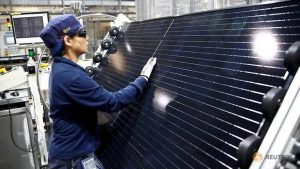
File photo of an employee making a final inspection on panels during a tour of an REC solar panel manufacturing plant in Singapore, May 5, 2017.
SINGAPORE: Singapore’s factory activity expanded slightly in July after five months of contractions.
The Purchasing Managers’ Index (PMI) for July came in at 50.2, up 2.2 points from the previous month, according to data released by the Singapore Institute of Purchasing and Materials Management (SIPMM) on Monday (Aug 3).
A PMI reading above 50 indicates that the manufacturing economy is generally expanding, while a reading below 50 indicates that it is generally declining.
Singapore implemented a “circuit breaker” from Apr 7 to Jun 1 to curb the spread of COVID-19. The country entered Phase 1 of its reopening on Jun 2, followed by Phase 2 on Jun 19.
July’s reading was attributed to an improvement in new orders index, a first-time expansion in the indexes of new exports and factory output, as well as a faster rate of expansion in the inventory index, said SIPMM.
Slower contractions were also recorded for the indexes of finished goods, imports, and input prices, while the order backlog index expanded for the first time after five months of contractions, said SIPMM.
However, the indexes of both employment and supplier deliveries contracted at faster rates. The overall employment index for the manufacturing sector also posted contractions for six consecutive months.
This suggests that the improvement in manufacturers’ sentiments has not extended to greater hiring intentions and that global supply disruptions has eased but not fully subsided, said Ms Selena Ling, head of treasury research and strategy at OCBC Bank.
Ms Sophia Poh, SIPMM’s vice president of industry engagement and development, said July’s reading was a “welcome respite” for Singapore’s manufacturing sectors.
“Local manufacturers remain concerned about the growth outlook due to continued uncertainties from the pandemic controls and the trade disputes of the major economies,” she added.
“The second and third waves of the COVID-19 pandemic in the major economies continue to disrupt global supply chains and dampen global demand.”
The electronics sector PMI rose 1.6 points from the previous month to post a slower contraction at 49.2 – the sixth month of contraction for the sector, said SIPMM.
July’s improved reading for the electronics sector was attributed to “slower contractions in the key indexes of new orders, new exports, and factory output”, it added.
However, both electronic employment and supplier deliveries recorded faster rates of contraction.
The electronics inventory index continued to expand for the third month, whereas electronics finished goods continued to contract for the fifth month.
SIPMM added that the electronics indexes of input prices and order backlog posted expansion readings, while the electronics imports index posted a slower rate of contraction.
OCBC’s Ms Ling said the recent US earnings season show that global technology companies such as Apple, Amazon.com, Facebook, and Alphabet are still thriving despite the COVID-19 pandemic as consumers work, shop and entertain from home.
“So the question is if Singapore’s electronics industry can ride this wave to capitalise on the broader industry trends,” said Ms Ling.
She added that she expects Singapore’s manufacturing sector to edge out a marginal positive year-on-year growth by the end of the year, after contracting in the second quarter and a likely weak showing in the third quarter.

